Changing Acoustic Guitar Strings might seem daunting at first, but it’s a fundamental skill every guitar player should master. Fresh strings can dramatically improve your guitar’s tone, making it sound brighter and more resonant. This guide will walk you through each step of changing your acoustic guitar strings, ensuring your instrument is sounding its best in no time.
First, let’s get your guitar ready for its string change and a little pampering. This is an excellent opportunity to clean parts that are usually hidden under the strings.
Step 1: Deep Cleaning Your Guitar
With the old strings removed, now is the perfect time for a deep clean. Dust and grime can accumulate in areas that are normally hard to reach, such as the fretboard, saddle, bridge, and scratchplate (if your guitar has one). Use a soft cloth to wipe down these areas and remove any buildup.
 Cleaning acoustic guitar bridge and saddle during string change
Cleaning acoustic guitar bridge and saddle during string change
Step 2: Hydrating the Fretboard with Lemon Oil
If your guitar has a dark wood fretboard like rosewood or ebony, applying lemon oil can help keep the wood hydrated and prevent it from drying out and cracking. Place a few drops of lemon oil on a clean cloth.
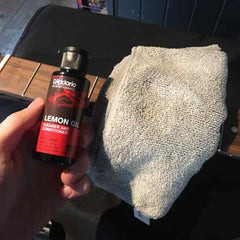 Applying lemon oil to acoustic guitar fretboard
Applying lemon oil to acoustic guitar fretboard
Step 3: Working Lemon Oil into the Fretboard
Gently work the lemon oil into the fretboard wood, moving along the grain of the wood. Don’t wipe all the oil away immediately; allow a small amount to soak in for about 30 seconds to nourish the wood.
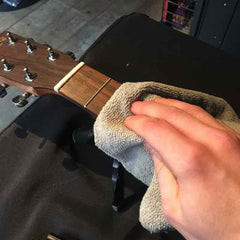 Lemon oil soaking into acoustic guitar fretboard
Lemon oil soaking into acoustic guitar fretboard
Step 4: Hydrating the Bridge (Optional)
If your guitar’s bridge looks dry, you can also apply a small amount of lemon oil to hydrate it. However, be careful to avoid getting oil on the saddle or remove it beforehand, as lemon oil can cause the strings to slip on the saddle, affecting tuning stability.
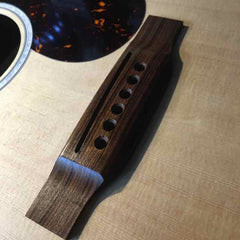 Applying lemon oil to acoustic guitar bridge – string change maintenance
Applying lemon oil to acoustic guitar bridge – string change maintenance
Step 5: Preparing Your New Acoustic Guitar Strings
Open your new set of acoustic guitar strings. Take a moment to identify the order of the strings – usually, they are numbered or color-coded. Understanding the string order is crucial for correctly restringing your guitar.
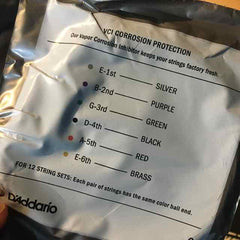 New acoustic guitar strings set for string replacement
New acoustic guitar strings set for string replacement
Step 6: Bending the String End for Ball End Insertion
Create a 45° bend at the ball end of the string. This bend helps ensure the ball end sits correctly against the bridge plate inside the guitar, which is important for tuning stability and preventing string slippage.
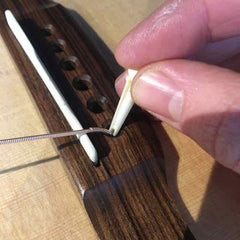 Bending acoustic guitar string end for secure bridge insertion
Bending acoustic guitar string end for secure bridge insertion
Step 7: Inserting the String and Bridge Pin
Push the ball end of the string into the bridge hole and secure it with the bridge pin. Make sure the string sits in the groove of the bridge pin and that the groove is facing towards the guitar neck for proper string alignment.
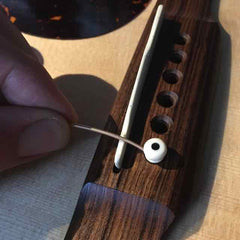 Inserting acoustic guitar string ball end with bridge pin
Inserting acoustic guitar string ball end with bridge pin
Step 8: Securing All Strings at the Bridge
Repeat steps 6 and 7 for all six strings. After inserting each string and pin, gently pull on the tail of the string to confirm that the ball end is firmly seated against the bottom of the bridge plate.
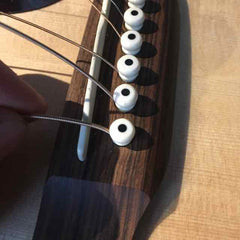 Acoustic guitar bridge with new strings and bridge pins installed
Acoustic guitar bridge with new strings and bridge pins installed
Step 9: Positioning Machine Heads for String Insertion
Ensure the holes in each machine head (tuning peg) are aligned straight down the guitar neck. This starting position makes string insertion easier and prepares for optimal winding.
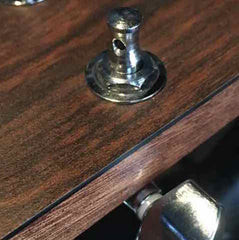 Acoustic guitar machine heads aligned for stringing
Acoustic guitar machine heads aligned for stringing
Step 10: Threading the String to the Machine Head
Bring the string over the saddle and nut, and then thread it through the hole in the corresponding machine head. Pull the string through, leaving some slack for winding.
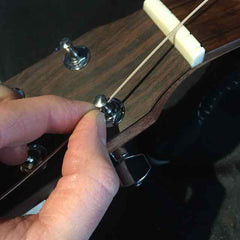 Threading acoustic guitar string through machine head
Threading acoustic guitar string through machine head
Step 11: Measuring String Length for Winding
Pull the string taut and measure approximately the distance to the next machine head along the headstock. This measurement determines the correct amount of string to wind around the tuning post, typically providing enough winds for tuning stability.
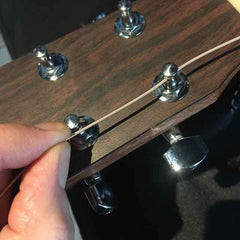 Measuring acoustic guitar string length for proper winding
Measuring acoustic guitar string length for proper winding
Step 12: Winding the String on the Machine Head
Pull the excess string length back through the machine head post. Begin winding the string counter-clockwise (for the lower strings, and clockwise for the higher strings on standard headstocks), maintaining some tension to keep your measured length consistent. The string should wind downwards towards the headstock, inside of the post.
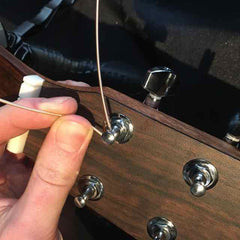 Winding acoustic guitar string onto tuning post
Winding acoustic guitar string onto tuning post
Step 13: Ensuring Neat String Wraps
As you wind, ensure the new string wraps sit neatly beneath the previous wraps, pushing them downwards. This technique keeps the string windings tidy and increases tuning stability by increasing downward pressure on the nut.
 Neat string wraps on acoustic guitar tuning post for stability
Neat string wraps on acoustic guitar tuning post for stability
Step 14: Initial String Tensioning
Tighten the string until there is a slight amount of tension. Just a couple of winds around the post at this stage are sufficient to hold the string in place and prepare for tuning.
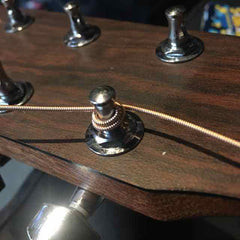 Applying initial tension to acoustic guitar string during restringing
Applying initial tension to acoustic guitar string during restringing
Step 15: Trimming Excess String
Use wire cutters to trim off the excess string beyond the machine head. Cutting close to the post creates a neater appearance and prevents the sharp string ends from being a hazard.
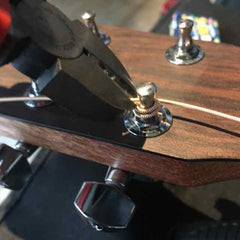 Trimming excess acoustic guitar string after winding
Trimming excess acoustic guitar string after winding
Step 16: Restringing All Strings
Repeat steps 10 through 15 for the remaining five strings, typically working from the thickest string to the thinnest. This systematic approach ensures even tension distribution on the guitar neck.
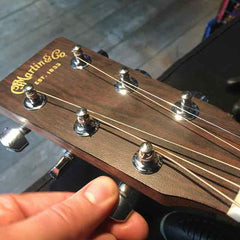 Acoustic guitar headstock with all new strings installed
Acoustic guitar headstock with all new strings installed
Step 17: Tuning to Pitch
Once all the strings are installed, use a tuner to bring them up to the correct pitch. Increase the tension gradually, moving back and forth between each string. This prevents uneven pressure on the neck and helps the guitar settle in tune more quickly. A clip-on guitar tuner is particularly useful for this step.
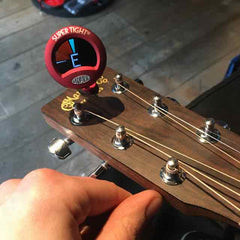 Tuning acoustic guitar with clip-on tuner after string change
Tuning acoustic guitar with clip-on tuner after string change
Step 18: Stretching the Strings
Stretching new strings is essential to prevent them from constantly going out of tune. Gently stretch each string by pulling it away from the fretboard along its length. Retune the guitar after stretching. Repeating this process a few times will significantly improve tuning stability and get you ready to play.
 Stretching new acoustic guitar strings to improve tuning stability
Stretching new acoustic guitar strings to improve tuning stability
Congratulations! You’ve successfully changed your acoustic guitar strings. Your guitar is now ready to play with a fresh, vibrant sound. Regular string changes, combined with proper technique, will keep your acoustic guitar sounding its best.
